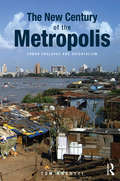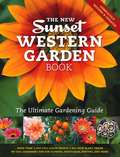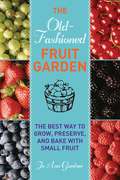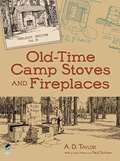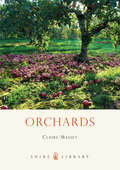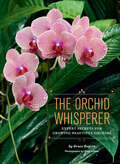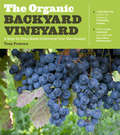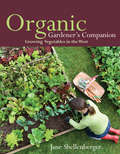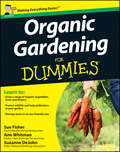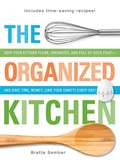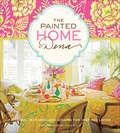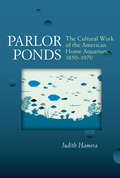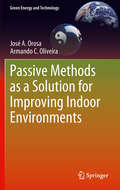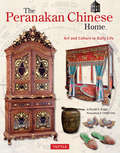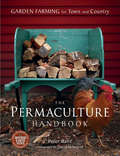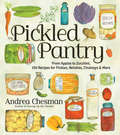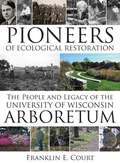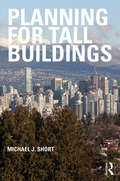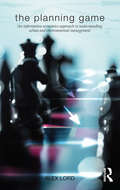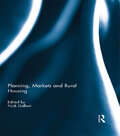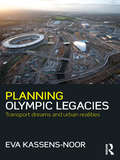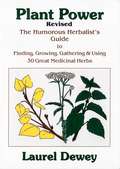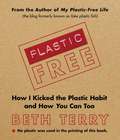- Table View
- List View
The New Century of the Metropolis: Urban Enclaves and Orientalism
by Tom AngottiThe problems created by metropolitanization have become increasingly apparent. Attempts to limit growth, disperse populations and plan neighbourhoods have been largely unsuccessful. Strategies are needed to improve the world's major cities in the twenty-first century. Tom Angotti is fundamentally optimistic about the future of the metropolis, but questions urban planning’s inability to integrate urban and rural systems, its contribution to the growth of inequality, and increasing enclave development throughout the world. Using the concept of 'urban orientalism' as a theoretical underpinning of modern urban planning grounded in global inequalities, Angotti confronts this traditional model with new, progressive approaches to community and metropolis. Written in clear, precise terms by an award-winning author, The New Century of the Metropolis argues that only when the city is understood as a necessary and beneficial acccompaniment to social progress can a progressive, humane approach to urban planning be developed.
The New Sunset Western Garden Book: The Ultimate Gardening Guide (Ninth Edition)
by Kathleen Norris BrenzelThis book is an indispensable reference for beginning and expert gardeners alike. Completely redesigned and updated, this ninth edition includes a fresh new look, thousands of color photographs, fresh illustrations, and an easy-to-follow format.
Old-Fashioned Fruit Garden: The Best Way to Grow, Preserve, and Bake with Small Fruit
by Jo Ann GardnerJo Ann Gardner and her husband, Jigs, have been farming for nearly four decades, specializing in fruit, dairy, and herb products. Jo Ann herself makes and sells seventy-five cases of jams, jellies, and preserves a year. She knows her subject well-and this breezy, delightful reissue of her classic text is a testament to the continued relevance of her years of gardening knowledge. Whether an old hand or a novice, you'll find The Old-Fashioned Fruit Garden enlightening and informative, not to mention enjoyable. In this updated and full-color edition of The Old-Fashioned Fruit Garden, Jo Ann takes you back to the basics.
Old-Time Camp Stoves and Fireplaces
by Paul Dickson A. D. TaylorCreated during the Great Depression by the U.S. Forest Service, this guide was designed to provide environmental safety and maintenance advice for visitors to national forests and parks. Loaded with finely crafted drawings and plans for outdoor stoves and fireplaces, this manual offers a window into a bygone era of handyman activity as well as a wealth of still-useful information for building barbecue pits, chimneys, warming units, and other outdoor heating sources.Coverage includes considerations of general design problems and their solutions; discussion of detailed designs, from foundations to chimneys; construction materials, including iron, brick, concrete, stone, and sand; and specific types of camp stoves and fireplaces. Do-it-yourselfers interested in older construction techniques will find this volume a source of many tried-and-true ideas and methods.
Orchards
by Claire MassetWhether in blossom and laden with fruit, orchards are places of great beauty. Throughout history, they have played an important role in country, and also city, life, providing not just food and drink, but also a haven for wildlife and a setting for age-old customs and social gatherings. Some of Britain's surviving orchards are almost 600 years old. But when did orchards first appear? Why are there over 3,000 varieties of apple, so varied in colour, shape, texture and taste? What is wassailing and who did it? Why has England lost almost two-thirds of its orchards since 1950 - and what is being done about it today? This beautifully illustrated book reveals the engaging story and rich diversity of Britain's orchards and answers many intriguing questions along the way.
The Orchid Whisperer: Expert Secrets for Growing Beautiful Orchids
by Bruce Rogers Greg AllikasOrchids can bloom year after year. In this essential guide, Bruce Rogers, "The Orchid Whisperer", shares his expert tips from more than three decades of breeding and growing orchids. The book demystifies the growing process and features more than 100 lush color photographs of breathtaking plants. Best of all, it reveals professional secrets not found anywhere else for blooming, repotting, spotting hazards and pests, grooming, decorating, and much more. Perfect for beginners as well as orchid experts looking for new tricks, The Orchid Whisperer provides everything readers need to know to keep healthy orchids that will flower again and again!
The Organic Backyard Vineyard: A Step-by-Step Guide to Growing Your Own Grapes
by Tom PowersInterest in wine shows no signs of slowing down—wine tours, tastings, and vacations are now common and homeowners often have space dedicated to their collection. The logical next step? Learning to grow and make your own.In The Organic Backyard Vineyard expert Tom Powers walks the small grower through the entire process of growing grapes, with a month-by-month maintenance guide covering all regions of the U.S. and Canada. He explains everything a beginning grape grower needs to know: how to design and build a vineyard, how to select grapes for each region, how to maximize yield using organic maintenance techniques, how to build a trellis, how to harvest at peak flavor, and how to store grapes for winemaking.This edition includes organic growing information and all new photography.
Organic Gardener's Companion: Growing Vegetables in the West
by Jane ShellenbergerLifelong gardener Jane Shellenberger brings us this comprehensive, hands-on guide to growing organic produce in the Rocky Mountain and western region, including Colorado, parts of New Mexico, Arizona, Utah, Wyoming, Montana, Idaho, and eastern Oregon. The text covers soil cultivation, plant selection, water, microclimates, and other concerns specific to semiarid and high-altitude climates. Color photographs enhance this easy-to-use and accessible gardening guide.Jane Shellenberger is an eclectic gardener and environmental activist. She is publisher and editor of the regional gardening magazine Colorado Gardener, a thinking gardener's companion, which she founded in 1997. She is also a member of the Garden Writers Association. Shellenberger lives on a five-acre farmette on the plains between Boulder and Longmont, Colorado.
Organic Gardening for Dummies, UK Edition
by Sue FisherReduce a garden's impact on both the environment and the walletOrganic Gardening For Dummies shows readers the way to ensure a healthy harvest from an environmentally friendly garden. It covers information on the newest and safest natural fertilizers and pest control methods, composting, cultivation without chemicals, and how to battle plant diseases. It also has information on updated equipment and resources. It helps the reader to plant organically year-round, using herbs, fruits, vegetables, lawn care, trees and shrubs, and flowers.Organic Gardening For Dummies show readers how to:Plan out the perfect organic gardenProtect wildlife and help pollinators in a gardenGrow a range of organic vegetables, fruits and flowersManage pests in an eco-friendly way
The Organized Kitchen: Keep Your Kitchen Clean, Organized, and Full of Good Food—and Save Time, Money, (and Your Sanity) Every Day!
by Brette SemberAn organized kitchen is the salvation every busy cook needs! You'll save yourself time, money, and stress-all while whipping up delicious, healthy meals your family and friends will love.From aprons to zesters, this book provides an A-Z of simple shortcuts that will make all the difference, including:Shelf and storage strategiesFive-minute kitchen feng shuiWhen to clean what-with whatThe right tools for the right tasksThe truth about freezing foodMeal plans that really workTen foolproof, must-know recipes-with endless variationsThe good-enough stocked pantryLeftovers you'll really want to eatWith tips and tricks from master chefs (think Julia Child's pegboard) and real-life home chefs (think Grandma's ingenious pasta pots), this is the only kitchen/food/life organizer you need to streamline your kitchen-once and for all!The Organized Kitchen: Because you can minimize cooking time and maximize good taste!
The Painted Home by Dena: Patterns, Textures, and Colors for Inspired Living
by Dena Fishbein John EllisA renowned designer shares surprising ways to add color, texture, and creativity to your home. In this beautifully illustrated book, the woman behind internationally acclaimed merchandise company Dena Designs shows how her hand-painted style combines vintage and traditional elements with a modern twist. Pick up a paintbrush and take a walk through the author’s own home, room by room, as she discusses her inspirations and demonstrates her methods for encouraging creativity. The Painted Home features simple DIY projects, useful design tips, and personal stories from one of the most successful entrepreneurs in the textile and design business.
Parlor Ponds: The Cultural Work of the American Home Aquarium, 1850-1970
by Judith HameraParlor Ponds: The Cultural Work of the American Home Aquarium, 1850–1970examines the myriad cultural meanings of the American home aquarium during the nineteenth and twentieth centuries and argues that the home aquarium provided its enthusiasts with a potent tool for managing the challenges of historical change, from urbanization to globalization. The tank could be a window to an alien world, a theater for domestic melodrama, or a vehicle in a fantastical undersea journey. Its residents were seen as inscrutable and wholly disposable “its,” as deeply loved and charismatic individuals, and as alter egos by aquarists themselves. Parlor Pondsfills a gap in the growing field of animal studies by showing that the tank is an emblematic product of modernity, one using elements of exploration, technology, science, and a commitment to rigorous observation to contain anxieties spawned by industrialization, urbanization, changing gender roles, and imperial entanglements. Judith Hamera engages advertisements, images, memoirs, public aquarium programs, and enthusiast publications to show how the history of the aquarium illuminates complex cultural attitudes toward nature and domestication, science and religion, gender and alterity, and national conquest and environmental stewardship with an emphasis on the ways it illuminates American public discourse on colonial and postcolonial expansion.
Passive Methods as a Solution for Improving Indoor Environments
by José A. Orosa Armando C. OliveiraThere are many aspects to consider when evaluating or improving an indoor environment; thermal comfort, energy saving, preservation of materials, hygiene and health are all key aspects which can be improved by passive methods of environmental control. Passive Methods as a Solution for Improving Indoor Environments endeavours to fill the lack of analysis in this area by using over ten years of research to illustrate the effects of methods such as thermal inertia and permeable coverings; for example, the use of permeable coverings is a well known passive method, but its effects and ways to improve indoor environments have been rarely analyzed. Passive Methods as a Solution for Improving Indoor Environments includes both software simulations and laboratory and field studies. Through these, the main parameters that characterize the behavior of internal coverings are defined. Furthermore, a new procedure is explained in depth which can be used to identify the real expected effects of permeable coverings such as energy conservation and local thermal comfort as well as their working periods in controlling indoor environments. This theoretical base is built on by considering future research work including patents and construction indications which will improve indoor environmental conditions with evidence from real data. This makes Passive Methods as a Solution for Improving Indoor Environments an ideal resource for specialists and researchers focusing on indoor air quality, thermal comfort, and energy saving or with a general interest in controlling indoor environments with passive methods.
The Peranakan Chinese Home
by A. Chester Ong Ronald G. KnappDiscover the rarified Peranakan (native-born Chinese of Southeast Asia) aesthetics that are today highly sought-after for their beauty: distinctive furniture and ceramics, textiles and jewelry, and many other art objects. Peranakan Chinese Home displays these extraordinary objects, visible markers of a highly developed culture.The broad range of beautiful objects which the Peranakan Chinese created and enjoyed in their daily lives is astounding. Each chapter in Peranakan Chinese Home focuses on a different area and presents objects used or found in those spaces. Each piece is described in the context of their utility as household objects, as part of periodic celebrations to mark the Chinese New Year and other holidays, or in important life passage rituals relating to ancestor worship, birth, marriage, mourning and burial. The meaning of the rich symbolic and ornamental motifs found on the objects is discussed in detail and key differences are highlighted between Peranakan objects and similar ones found in China.A fascinating mix of Chinese, European and Southeast Asian influences, the distinctly Peranakan identity of a people and their culture is beautifully portrayed through objects and archival photographs in this lovely and exotic book.
The Peranakan Chinese Home
by A. Chester Ong Ronald G. KnappDiscover the rarified Peranakan (native-born Chinese of Southeast Asia) aesthetics that are today highly sought-after for their beauty: distinctive furniture and ceramics, textiles and jewelry, and many other art objects. Peranakan Chinese Home displays these extraordinary objects, visible markers of a highly developed culture.The broad range of beautiful objects which the Peranakan Chinese created and enjoyed in their daily lives is astounding. Each chapter in Peranakan Chinese Home focuses on a different area and presents objects used or found in those spaces. Each piece is described in the context of their utility as household objects, as part of periodic celebrations to mark the Chinese New Year and other holidays, or in important life passage rituals relating to ancestor worship, birth, marriage, mourning and burial. The meaning of the rich symbolic and ornamental motifs found on the objects is discussed in detail and key differences are highlighted between Peranakan objects and similar ones found in China.A fascinating mix of Chinese, European and Southeast Asian influences, the distinctly Peranakan identity of a people and their culture is beautifully portrayed through objects and archival photographs in this lovely and exotic book.
The Peranakan Chinese Home
by Ronald G. Knapp A. Chester OngDiscover the rarified Peranakan (native-born Chinese of Southeast Asia) aesthetics that are today highly sought-after for their beauty: distinctive furniture and ceramics, textiles and jewelry, and many other art objects. Peranakan Chinese Home displays these extraordinary objects, visible markers of a highly developed culture.The broad range of beautiful objects which the Peranakan Chinese created and enjoyed in their daily lives is astounding. Each chapter in Peranakan Chinese Home focuses on a different area and presents objects used or found in those spaces. Each piece is described in the context of their utility as household objects, as part of periodic celebrations to mark the Chinese New Year and other holidays, or in important life passage rituals relating to ancestor worship, birth, marriage, mourning and burial. The meaning of the rich symbolic and ornamental motifs found on the objects is discussed in detail and key differences are highlighted between Peranakan objects and similar ones found in China.A fascinating mix of Chinese, European and Southeast Asian influences, the distinctly Peranakan identity of a people and their culture is beautifully portrayed through objects and archival photographs in this lovely and exotic book.
The Permaculture Handbook
by David Holmgren Peter BaneThe urban landscape has swallowed vast swaths of prime farmland across North America. Imagine how much more self-reliant our communities would be if thirty million acres of lawns were made productive again. Permaculture is a practical way to apply ecological design principles to food, housing, and energy systems, making growing fruits, vegetables, and livestock easier and more sustainable.The Permaculture Handbook is a step-by-step, beautifully illustrated guide to creating resilient and prosperous households and neighborhoods, complemented by extensive case studies of three successful farmsteads and market gardens. This comprehensive manual casts garden farming as both an economic opportunity and a strategy for living well with less money. It shows how, by mimicking the intelligence of nature and applying appropriate technologies such as solar and environmental design, permaculture can:*Create an abundance of fresh, nourishing local produce *Reduce dependence on expensive, polluting fossil fuels*Drought-proof our cities and countryside*Convert waste into wealthPermaculture is about working with the earth and with each other to repair the damage of industrial overreach and to enrich the living world that sustains us. The Permaculture Handbook is the definitive practical North American guide to this revolutionary practice, and is a must-read for anyone concerned about creating food security, resilience, and a legacy of abundance rather than depletion.Peter Bane is a permaculture teacher and site designer who has published and edited Permaculture Activist magazine for over twenty years. He helped create Earthaven Ecovillage in North Carolina, and is now pioneering suburban farming in Bloomington, Indiana.
The Pickled Pantry: From Apples to Zucchini, 150 Recipes for Pickles, Relishes, Chutneys & More
by Andrea ChesmanBlending your grandmother&’s pickling know-how with today&’s Internet resources, Andrea Chesman shows you how easy it is to fill your pantry with tasty homemade sauerkraut, Salt-Cured Dilly Beans, and Rosemary Onion Confit. Explaining classic techniques in simple language, guiding you to helpful websites, and making you laugh with humorous stories, Chesman provides inspiration and encouragement for both first-time picklers and dedicated home canners. With tips on pickling everything from apples to zucchini, you&’ll enjoy exploring the stunning variety of flavors that can fill a Mason jar.
Pioneer of Ecological Restoration
by Franklin E. CourtInternationally renowned for its pioneering role in the ecological restoration of tallgrass prairies, savannas, forests, and wetlands, the University of Wisconsin Arboretum contains the world's oldest and most diverse restored ecological communities. A site for land restoration research, public environmental education, and enjoyment by nature lovers, the Arboretum remains a vibrant treasure in the heart of Madison's urban environment.
Planning for Tall Buildings
by Michael J. ShortIn a time of recession, the challenge of building and planning for tall buildings has become even more complex; the economics of development, legislative and planning frameworks, and the local politics of development must be navigated by those wishing to design and construct new tall buildings which fit within the fabric of their host cities. This book is a timely contribution to the debate about new tall buildings and their role and effect on our cities. It is divided into two main parts. In part one, the relationship between tall buildings and planning is outlined, followed by an exploration of the impacts that construction of tall buildings can have. It focuses, in particular, on the conservation debates that proposals for new tall buildings raise. The first part ends with an analysis of the way in which planning strategies have evolved to deal with the unique consequences of tall buildings on their urban locations. The second part of the book focuses on seven examples of medium-sized cities dealing with planning and conservation issues, and implications that arise from tall buildings. These have been chosen to reflect a wide range of methods to either encourage or to control tall buildings that cities are deploying. The case studies come from across the western world, covering England (Manchester, Liverpool, Newcastle and Birmingham), Norway (Oslo), Ireland (Dublin) and Canada (Vancouver) and represent a broad spectrum of approaches to dealing with this issue.In drawing together the experiences of these varied cities, the book contributes to the ongoing debate about the role of the tall building in our cities, their potential impacts, and experiences of those who use and inhabit them. The conclusions outline how cities should approach the strategic planning of tall buildings, as well as how they should deal with the consequences of individual buildings, particularly on the built heritage.
The Planning Game: An Information Economics Approach to Understanding Urban and Environmental Management
by Alex LordTrading information is an essential aspect of the negotiations that underpin planning practice across the globe. In this book, Alex Lord uses information economics to outline a way of thinking about these negotiations that places the strategies that actors in the planning game use at the heart of the debate. Dialogue between economics and planning theorists has been, until now, rare. Lord argues that information economics’ tool kit, game theory – including well-known examples such as the Prisoners’ Dilemma, the Stag Hunt game and Follow the Leader – offers an analytical framework ideally suited to unpacking planning processes. This use of game theory to understand how counterparties interact draws together two distinct bodies of literature: firstly the mainstream economics treatment of games in abstract form and, secondly, accounts of actual bargaining in planning practice from a host of international empirical studies. Providing a novel alternative to existing theories of planning, The Planning Game provides an explanation of how agencies interact in shaping the trajectory of development through the application of game theory to planning practice.
Planning, Markets and Rural Housing
by Nick GallentThis book analyses the key forces affecting the affordability of rural homes in Britain and the changing shape of housing markets. It takes as its starting point, demographic trends impacting upon rural communities and upon market dynamics. From this point, it explores consequent patterns of housing affordability, examining changing opportunities in the rental and sale markets, at different spatial scales. The book also focuses on how markets are analysed, and how data are selectively used to demonstrate low levels of affordability, or a lack of need for additional housing in small village locations.Building on the demographic theme, the book considers the housing implications of an aging population, before the focus finally shifts to community initiative in the face of housing undersupply and planning's future role in delivering and procuring a more constant and predictable supply of affordable homes. In a speculative conclusion, the book ends by examining the current political trajectory in England, and the prospects for housing in the countryside in the context of localism and neighbourhood planning at a village level.This book was published as a special issue of Planning Practice and Research.
Planning Olympic Legacies: Transport Dreams and Urban Realities
by Eva Kassens-NoorWhen a city wins the right to hold the Olympics, one of the oft cited advantages to the region is the catalytic effect upon the urban and transport projects of the host cities. However, with unparalleled access to documents and records, Eva Kassens-Noor questions and challenges this fundamental assertion of host cities who claim to have used the Olympic Games as a way to move forward their urban agendas In fact, transport dreams to stage the "perfect games" of the International Olympic Committee and the governments of the host cities have lead to urban realities that significantly differ from the development path the city had set out to accomplish before winning the Olympic bid. Ultimately it is precisely the IOC’s influence – and the city’s foresight and sophistication (or lack thereof) in coping with it – that determines whether years after the Games there are legacies benefitting the former hosts. The text is supported by revealing interviews from lead host city planners and key documents, which highlight striking discrepancies between media broadcasts and the internal communications between the IOC and host city governments. It focuses on the inside story of the urban and transport change process undergone by four cities (Barcelona, Atlanta, Sydney, and Athens) that staged the Olympics and forecasts London and Rio de Janeiro’s urban trajectories. The final chapter advises cities on how to leverage the Olympic opportunity to advance their long-run urban strategic plans and interests while fulfilling the International Olympic Committee’s fundamental requirements. This is a uniquely positioned look at why Olympic cities have – or do not have – the transport and urban legacies they had wished for. The book will be of interest to planners, government agencies and those involved in organizing future Games.
Plant Power
by Laurel DeweyPLANT POWER is your one-stop guide to effectively growing and using thirty great medicinal herbs. Offering first-hand knowledge and years of herbal experience, author Laurel Dewey (aka "The Humorous Herbalist") leads readers on a step-by-step journey that takes you from your own backyard and into the wild green yonder. Learn when to plant seeds, what time of year is best for harvesting, which parts of the plant are the most medicinally potent, and how to preserve herbs for later use. Discover timesaving secrets on ways to avoid common herb garden mistakes and how to get the most out of your medicinal bounty. As an added bonus, you will learn which herbs can be sliced, diced, and pounded into "wild food" recipes that contain vitamins, minerals, and energy-sustaining protein.Everything you need to become "herbally" self-sufficient is here:* Why would you want to purposely sting yourself with a stinging nettle?* What can alfalfa and red clover do to improve poor garden soil?* When does usnea, a common tree fungus, turn into an incredible anti-viral agent?* Would you believe that pine sap could prevent infections in a wound?* How can "weeds" such as burdock, chickweed, and yellow dock keep you healthy and full of energy?The answers to these and other herbal questions are at your fingertips. So, grab a shovel, get some seeds, and start that medicinal garden.
Plastic-Free
by Beth TerryLike many people, Beth Terry didn't think an individual could have much impact on the environment. But while laid up after surgery, she read an article about the staggering amount of plastic polluting the oceans and decided then and there to kick her plastic habit. Now she wants to teach you how you can too. In her quirky and humorous style--well known to the readers of her popular blog, My Plastic-Free Life--Terry provides personal anecdotes, stats about the environmental and health problems related to plastic, and personal solutions and tips on how to limit your plastic footprint. Terry includes handy lists and charts for easy reference, ways to get involved in larger community actions, and profiles of individuals-- Plastic-Free Heroes--who have gone beyond personal solutions to create a change on a larger scale. Plastic-Free also includes chapters on letting go of eco-guilt, strategies for coping with overwhelming problems, and ways to relate to other people who aren't as far along on the plastic-free path. Both a practical guide and the story of a personal journey from helplessness to empowerment, Plastic-Free is a must-read for anyone concerned about the ongoing health and happiness of themselves, their children, and the planet.
